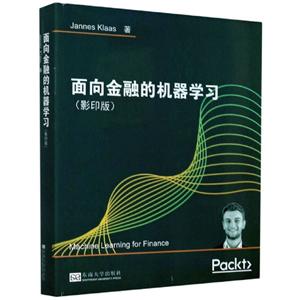中圖網小程序
一鍵登錄
更方便
本類五星書更多>
-
>
全國計算機等級考試最新真考題庫模擬考場及詳解·二級MSOffice高級應用
-
>
決戰行測5000題(言語理解與表達)
-
>
軟件性能測試.分析與調優實踐之路
-
>
第一行代碼Android
-
>
JAVA持續交付
-
>
EXCEL最強教科書(完全版)(全彩印刷)
-
>
深度學習
面向金融的機器學習(影印版) 版權信息
- ISBN:9787564189556
- 條形碼:9787564189556 ; 978-7-5641-8955-6
- 裝幀:一般膠版紙
- 冊數:暫無
- 重量:暫無
- 所屬分類:>
面向金融的機器學習(影印版) 內容簡介
近年來,大數據、云計算、人工智能以及區塊鏈等新興技術的快速發展和應用推動了金融業的巨大變革,金融科技開始滲透傳統金融業的各個領域和各個環節,如銀行、證券、保險以及前臺、中臺、后臺,傳統業務無不受到金融科技的挑戰。在諸多新興技術之中,人工智能和機器學習對傳統金融業的沖擊愈加明顯,也越來越具備顛覆性。人工智能在金融領域的應用具有天然優勢,它在處理數據方面有很強的優勢,而金融領域本質上就是要處理信息、處理數據,所以人工智能和金融業可以說是天作之合。本書講解相關知識。
面向金融的機器學習(影印版) 目錄
Preface
Chapter 1:Neural Networks and Gradient.Based optimization
Our iourney in this book
What iS machine Iearning?
Supervised Iearning
Unsupervised learning
Reinforcement learning
The unreaS0nabIe effectiveness of data
AIl models are wrong
Setting up your workspace
Using Kaggle kernels
Running notebooks Iocally
Installing TensorFIow
Installing Keras
Using data locally
Using the AWS deep learning AMI
Approximating functions
A forward pass
A logistic regressor
Python version of our Iogistic regressor
optimizing model parameters
Measuring modelloSS
Gradient descent
Backpropaqation
Parameter updates
Putting it all together
A deeper network
A brief introduction to Keras
lmporting Keras
A two-layer modeIin Keras
Stacking layers
Compiling the model
Training the model
Keras and TensorFIow
Tensors and the computational graph
Exercises
Summary
Chapter 2:Applying Maching Learning to Structured Data
The data
Heuristic,feature.based。and E2E models
The machine Iearning software stack
The heuristic approach
Making predictions using the heuristic model
The F1 score
Evaluating with a confusion matrix
The feature engineering approach
A feature from intuition—fraudsters don’t sleep
Expeinsight—transfer.then cash out
StatisticaI quirks—errors in balances
Preparing the data for the Keras library
One-hot encoding
Entity embeddings
Tokenizing categories
Creating input models
Training the model
Creating predictive models with Keras
Extracting the target
Creating a test set
Creating a validation set
Oversampling the training data
Building the model
Creating a simple baseline
Building more complex models
A brief primer on tree-based methods
A simple decision tree
A random forest
XGBoost
E2E modeling
Exercises
Summary
Chapter 3:Utiliziting Computer Vision
……
Chapter 4:Understanding Time Series
Chapter 5:Parising Textual Data with Natural Language
Chapter 6:Using generative Models
Chapter 7:Reinforcement Learning for Financial Markets
Chapter 8:Privacy,Debugging,and Launching Your Products
Chapter 9:Fighting Bias
Chapter 10:Bayesian Infernence and Probabilisitic
Other Books You May Enjoy
Index
Chapter 1:Neural Networks and Gradient.Based optimization
Our iourney in this book
What iS machine Iearning?
Supervised Iearning
Unsupervised learning
Reinforcement learning
The unreaS0nabIe effectiveness of data
AIl models are wrong
Setting up your workspace
Using Kaggle kernels
Running notebooks Iocally
Installing TensorFIow
Installing Keras
Using data locally
Using the AWS deep learning AMI
Approximating functions
A forward pass
A logistic regressor
Python version of our Iogistic regressor
optimizing model parameters
Measuring modelloSS
Gradient descent
Backpropaqation
Parameter updates
Putting it all together
A deeper network
A brief introduction to Keras
lmporting Keras
A two-layer modeIin Keras
Stacking layers
Compiling the model
Training the model
Keras and TensorFIow
Tensors and the computational graph
Exercises
Summary
Chapter 2:Applying Maching Learning to Structured Data
The data
Heuristic,feature.based。and E2E models
The machine Iearning software stack
The heuristic approach
Making predictions using the heuristic model
The F1 score
Evaluating with a confusion matrix
The feature engineering approach
A feature from intuition—fraudsters don’t sleep
Expeinsight—transfer.then cash out
StatisticaI quirks—errors in balances
Preparing the data for the Keras library
One-hot encoding
Entity embeddings
Tokenizing categories
Creating input models
Training the model
Creating predictive models with Keras
Extracting the target
Creating a test set
Creating a validation set
Oversampling the training data
Building the model
Creating a simple baseline
Building more complex models
A brief primer on tree-based methods
A simple decision tree
A random forest
XGBoost
E2E modeling
Exercises
Summary
Chapter 3:Utiliziting Computer Vision
……
Chapter 4:Understanding Time Series
Chapter 5:Parising Textual Data with Natural Language
Chapter 6:Using generative Models
Chapter 7:Reinforcement Learning for Financial Markets
Chapter 8:Privacy,Debugging,and Launching Your Products
Chapter 9:Fighting Bias
Chapter 10:Bayesian Infernence and Probabilisitic
Other Books You May Enjoy
Index
展開全部
書友推薦
- >
二體千字文
- >
龍榆生:詞曲概論/大家小書
- >
巴金-再思錄
- >
史學評論
- >
人文閱讀與收藏·良友文學叢書:一天的工作
- >
羅庸西南聯大授課錄
- >
羅曼·羅蘭讀書隨筆-精裝
- >
名家帶你讀魯迅:朝花夕拾
本類暢銷















